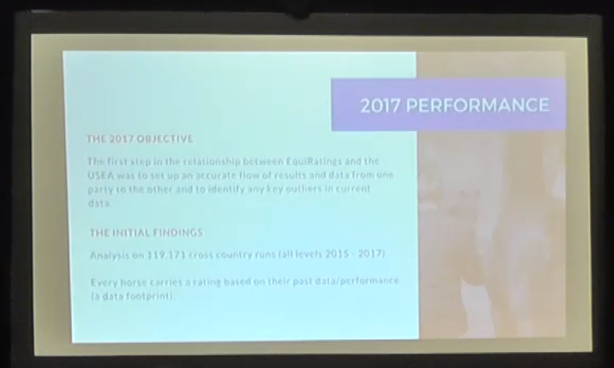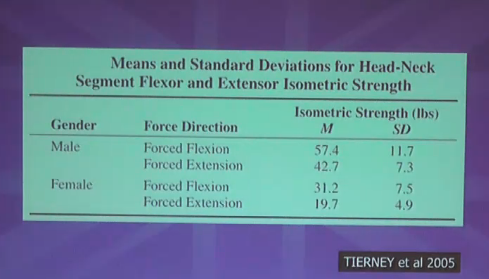I’ve always had a hard time being a casual enthusiast about anything. I either really dislike something or really love something, and if I really love it, I can be a wee bit obsessive. So when USEA announced that they were going to live stream the Annual Convention, I put my on geek glasses (theoretical, of course) and got to planning. The schedule made it such that I really had to pick and choose, and some of those choices were hard. Usually they had several streams going at once, plus they were on Pacific time so I missed some due to the fact that I…. ya know… had to peel myself away to go ride my horse. But on Friday and Saturday I managed to catch several different presentations, and of course I took notes!

First up – Equiratings! USEA will be implementing Equiratings as an assessment tool to help minimize risk of horse falls. Basically every horse will get a rating based on past performances.






EquiRatings
- already implemented in Ireland, where they saw a 15% decrease in falls at 2* level by removing less than 5% of competitors at highest risk
- ratings will be by horse
- ERQI (EquiRatings Quality Index) scale goes from 0-1
- there will be outliers – horses that are not at risk for fall but have “bugaboo” fences types that cause consistent refusals
- main goal is RISK MANAGEMENT
- think of this is an assessment tool for your horse and it’s current progress
- competitions can carry their own risk ratings
- this is not a qualification – it is a pilot program that will be open to feedback and changes
Next was Marilyn Payne going over the major changes to the new 2018 dressage tests, explaining what the new movements are looking for, and giving tips on a few things.
2018 Dressage Tests
- All of A’s you track left, all of B’s you track right
- B’s are harder test
- Included as many mirror image movements as possible
- All free and medium walks are separately scored
- Every halt is a separate score
- Prelim trot work rising or sitting
- Extended free walks to long diagonals
- coefficients taken out of walk scores since there are now separate walk scores
- BN test – don’t have to trot all the way up to the scary judge at C or do 10m half circle from centerline
- N test – 2 loop serpentine, stretch circle in Novice B
- Training A – 10m half circle left, then right. Training B – teardrop shape. “develop a lengthening” – don’t just come blasting out of the corner.
- Change your diagonal at the end of the change of direction.
- Come back to working from lengthening after center line on canter circles.
- Halt/reinback introduced at Mod B
- Prelim A – few changes in movements, Prelim B counter canter loop to X instead of quarter line. Stretch serpentine (like FEI test).
- Halt score – not just about being square, its about the balance going into the transition as well as immobility
- Leg yield – almost completely parallel to the rail with just a slight flexion of the head. Many people overbend the neck/shoulder.
After that was an open forum session on the Classic 3Day series.
Classic 3Day
- needs to be a sample conditioning program on the USEA site
- suggestion about sending an “info packet” to riders when they enter so they have a better idea of what to expect
- Colleen Rutledge: likes using the classic format for developing horses, especially crossbreds, so they start learning how to handle themselves when they begin to feel tired
- how to draw more entries – prizes? event sponsors to offset organizer costs?
- if you want classic format in your area, ask the organizers, tell the area chairs, etc. A lot of organizers won’t take on the additional expense/work unless they think it will draw enough competitors to be worthwhile.
AND THEN… on to the Future Event Horse program discussion with FEH judge Robin Walker.
FEH
- We’re seeing better quality horses and more of them
- it’s always clear who takes the time to properly prepare their horses both for the triangle and the free jumping – preparation is KEY to good results
- first year of 4yo FEH was a success, provided a good segue for 4yo’s who were not ready for YEH
- USEA will provide an experienced, professional team to run the horses through the free jump chute (this will be optional whether you want to use them or do it yourself)
- RW thinks the program has outgrown the infrastructure that supports it
- they want to create of system of apprenticeship, seminars, and online testing and continuing education courses for judges.
- judges have to start attending FEI jogs and learn to spot what a 1*, 2*, 3*, and 4* horse looks like – one of the biggest complaints is that judges aren’t taking future potential into consideration enough
- introducing “dealbreakers” to judges – things that should automatically knock a horse down from the top placings
- RW wants to see USEA provide a platform for registration for farms/breeders so that riders and owners are more easily able to find purpose-bred horses in the US
Carrying right along from FEH to YEH, there are a lot of big (and IMO good) changes coming to the YEH program.

Young Event Horse
- common request – make the judging shorter. There is a new revised scoresheet and they have simplified the judging.
- Simplify qualifiers to make them easier to run – conformation will only be judged at championships (qualifiers will be 70% jumping, 30% dressage), no halt in qualifying test
- Option fences at championships – one SJ, one XC – a higher or more technical fence to give the rider the option to show off a horse with more power/scope or rideability. You will not be penalized for choosing not jumping it, but if you jump it and it goes badly, it can affect the score.
- 4yo and 5yo qualifying tests are almost identical except for lengthenings and size of circles, so it’s easier for riders to remember
- USEA ultimately wants to develop an American young horse system that goes from FEH to YEH to a 6yo 1* and 7yo 2* program, just like the European model.
- Finals will be held over 2 consecutive days at each coast, total of four days back to back, thur/fri at Fair Hill, Sat/Sun at Fresno
- Courses will be as identical as possible on each coast (Fresno chosen because it is more similar to FH)
- Criteria and scale for judging – under 5, not an event horse, 5’s BN/N potential, 6’s T potential, low 7’s Prelim potential, high 7’s Int, 8-9 Adv 3* 4*
The adult rider one was a bit of a snooze for me until Bunnie and Boyd showed up to speak and answer questions, although I was greatly amused at the exponential increase in girlish GIGGLING from the audience as soon as Boyd took the floor.
Adult Rider
- USEA is looking to do a 3 year cycle for AEC’s with 2 years east of the Mississippi and then one year west of the Mississippi
- 2017 – 3 shows offering Modified, 2018 – 17 shows offering Modified. This division will line up with new FEI 2019 1* specs, so it’s expected to grow over the next two years.
Bunnie:
- Clinics are fun and great, but if you have limited funds, put your money into having a great trainer that can give you a very solid foundation.
- The best horses when you’re at the lower level are the ones that can tolerate your mistakes, find a kind horse, not a world-beater.
Boyd:
- being nervous is healthy
- Lots of people’s idea of a hobby is sitting on the couch drinking beer and watching NASCAR. We feel a lot more pressure than they do, but remember that the pressure is a privilege – take a deep breath and enjoy the moment.
- think through the course, but don’t let it consume you. Concentrate but don’t overthink it.
- believe in the work you’ve done at home
- to be a great XC rider you have to have the ability to react well when things go wrong – accept that it’s not going to be perfect and instead focus on how to recover quickly and move past it
- if you make the warm-up too perfect, things go wrong on course – so in the warmup get some smaller fences out of rhythm, practice the more forward distance, but also challenge yourself to turn in the air or angle fences or try for a less perfect distance. Get the horse and rider focused on the challenges.
- You can improve a horse, but you can’t change him.
- It’s not just the result you’re after. Winning is fun but if you want to improve, be self-critical of your own riding. Compare videos of your riding to the top riders to find things you can do better.
- Cross country is all about confidence, and confidence comes from training.
Then I flipped over to the second half of a presentation by an Adequan guy, which was really really really awkward to watch. I was cringing by the end. Mostly it was just a presentation about why Adequan is amazing, which is fine, but when presented with specific questions there was a lot of dodging.




Constructing a Wellness Program for the Aging Horse
- Good decisions and good management are the best way to keep horses sound
- Adequan dosage – one injection every 4 days for 7 doses has shown to have the most benefit.
- Really hesitant to answer question about how often to do the 7 dose protocol and never gave an actual answer or range. Basically said it depends on the horse, what the issue is, how much damage there is, and how you manage the horse. Someone kept pressing and asked “once a year?” and he said “maybe”, finally ended up saying that he knows some Advanced horses do once a quarter, then admitted they need to do more research in that regard.
I watched parts of the presentation from the Charles Owen guy about the differences in injuries by gender while I was waiting for another feed to start but it was so sciencey that honestly most of it went way the heck over my head. The main takeaway was that brain and neck injuries can be more severe for women, and women take longer to recover from them. Here’s a bunch of slides with charts and stuff.
How Rider Injuries Differ by Gender




The Rule Change Open Forum was a must-watch of course, although nothing really earth shattering is coming for eventing, and my feed kept dropping out so I missed parts of the explanations and some Q & A.
Rule Changes
- Bits out of rule book and into annex to allow for faster changes and updates
- nose nets will be allowed with signed letter from vet
- allowing brown helmets Dec 1 2018
- glue on shoes legal
- specifically naming the cross country controller under personnel, with criteria for that job
- when measuring a spread fence – including specific verbiage to measure the spread where it is intended for the horse to jump
- qualifications for dressage penalties changes to 45pp, since FEI coefficient is gone
- Safe Sport Initiative
Overall I really LOVED having the live stream. I always want to attend the convention but it’s not cheap and it’s hard to get days off of work this time of year. Being able to log in and watch any/all of it was fantastic.

Thanks for the recap! I tried to watch a little, but work and life and etc. made it a little difficult. The TBI stuff gender difference stuff is fascinating, although I’m a medical geek at heart so that makes sense. The dressage test info is really useful too!
LikeLike
Interesting stuff, despite the fact that I’m not remotely ever going to event. But…what’s a nose net?
LikeLike
Attaches to cavesson, kind of a fly net…. some chronic head shakers show marked improvement while wearing them (why vet note is needed).
LikeLike
Really interesting information! I LOVE the notes you took from Boyd’s speech, they’re 100% absolutely in line with his easy-going and down-to-earth personality. I heart Boyd.
LikeLike
Very interesting. I love watching streams but haven’t jumped into keeping up with rule changes as they don’t affect me right now. But your summaries are really interesting. It sounds like there are a lot of changes looking to encourage people to develop stateside talent. It will be interesting to see how all this plays out.
LikeLike
First off, yes, you are a complete NERD. Second off, best quote is from Bunnie: “The best horses when you’re at the lower level are the ones that can tolerate your mistakes, find a kind horse, not a world-beater.” So many people with baby horses or fresh OTTBs when they really just need a kind horse.
LikeLike
This. I feel like this is the same in all horse sports. Find a horse you can learn on without dying. Learn. Then try for something fancier. (Or keep going with the kind and willing ones. Willingness will get you further than fancy any day. Though, that same thing applies to the rider, too! 😉 )
LikeLike
This was super helpful! Thanks for this! I think I accidentally browsed by this when it showed up in my feed so I had no idea it was a live stream convention this weekend. And perhaps a nerd, but this is important nerd things! You’re just thorough lol. On the Adequan though, I was reading a DVM’s assessment of FDA approved drugs, and they were saying the best results they’ve seen for Adequan is the loading dose 1x a year, and then perhaps sort of a “booster” shot a few days before an important show. I just thought that was interesting that that seemed to work better than the 1x a month they suggest. Either way, this was really informative – thank you!
LikeLike
Interesting that they think estrogen is protective against TBI. For some other types of injury, like ACL tears, higher levels of estrogen are harmful. http://www.mrjonathanwebb.co.uk/new-study-finds-birth-control-pills-can-lessen-chance-knee-injury-female-athletes/
LikeLike
So interesting. Boyd’s bit sounded verbatim like what he said at the clinic. And question- where were you meant to change your diagonal originally? I always thought it was up to the rider?
LikeLike
Someone asked MP where the best place was, and she advised always doing it at the end of the change of direction because it was less likely to disrupt the rhythm of the horse.
LikeLike
That’s where I tend to do my change as well. If it’s good for MP, it’s sure as heck good for me.
LikeLiked by 1 person
I read on EN that the videos will be available to watch on demand, in case there are any you missed that you were interested in.
LikeLike
I saw that! I want to go back and watch the Course Design one, I only caught a few minutes.
LikeLike